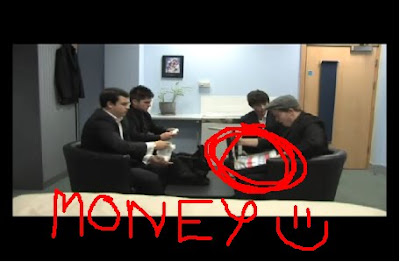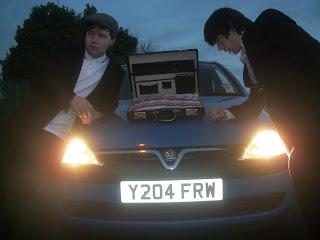Our initial idea for a film was a very dark and twisted story about an alcoholic father who was seen as a hero in his sons’ eyes.
 However, after pitching this idea to our classmates and our teacher we took their feedback into consideration and re thought our decisions. They made comments such as, “it’s just another story about an alcoholic” and “it’s a story but where is the depth?” These comments really set us back and knocked our confidence in it because if our target audience didn’t like the idea of it in the beginning why would they like the final product; it wasn’t worth making. So from this audience feedback we learned that we needed to come up with a better idea or else our final film wouldn’t have been appealing at all. So back to the drawing board we went and we decided to look at the theme of the fall from another angle. Rather than making a typical tragedy we wanted to make a comedy. This would challenge all stereotypes of what “the fall” really means and would be something unique. After all, we were all aiming for something that has never been done before. So we used a similar style of story as famous Director Guy Ritchie and generated a new film idea based on two best friends trying to make money quickly in order to buy a car.
However, after pitching this idea to our classmates and our teacher we took their feedback into consideration and re thought our decisions. They made comments such as, “it’s just another story about an alcoholic” and “it’s a story but where is the depth?” These comments really set us back and knocked our confidence in it because if our target audience didn’t like the idea of it in the beginning why would they like the final product; it wasn’t worth making. So from this audience feedback we learned that we needed to come up with a better idea or else our final film wouldn’t have been appealing at all. So back to the drawing board we went and we decided to look at the theme of the fall from another angle. Rather than making a typical tragedy we wanted to make a comedy. This would challenge all stereotypes of what “the fall” really means and would be something unique. After all, we were all aiming for something that has never been done before. So we used a similar style of story as famous Director Guy Ritchie and generated a new film idea based on two best friends trying to make money quickly in order to buy a car. After writing a completely new treatment and scripts to accompany it, we pitched this second idea to our classmates and teacher again and the feedback was a lot more positive. Individuals made comments like, “the idea is simple yet effective” and others “really liked the double act.” One issue we had was generating ideas to show the double act trying to make money. They would first try and sell cookies because Charlie ate one right after they found the car for sale. After that scene we had to somehow represent Charlie pretending to be blind so that they could beg for money, claiming it was for charity. However, we didn’t know how to illustrate this in a way that was funny but not unrealistic. We originally had one of the door to door cookie customers punch him in the face for being forceful with cookie sales, but our classmates soon pointed out that was “very abrupt” and “out of the blue.” So we suggested having Frank flick him in the eye instead, for eating more cookies and ultimately eating the profits.
 Due to the honest feedback they gave us we were able to save the film from losing its comedy. All of the feedback we received from both pitches helped us to decide that this double act /comedy/ mobster film would be our final idea and we could therefore finalise our treatment and begin drafting a storyboard. Using the audience feedback from our pitch, as a group, we knew that having such a simple film idea meant we would have to present it in a very interesting way. So each shot started off as just an idea of what to show that was necessary to be communicated to the audience but then we thought of the most appealing way to present it. For example, using split screen to show the double act being turned away from door to door cookie sales. Once we completed the storyboard we showed it to members of our class to see if they could follow the story easily as well as find it pleasing to the eye. They gave us positive feedback such as, “the over the roof shots using the car can make the beginning of the film funny introduce the humour.” In addition to this, numerous students stated “the over the shoulder laughing shots in the hotel room would really set the scene and make the double act feel uncomfortable.” So we unanimously decided to finalise the drawn storyboard and progress to the photo storyboard so we could see, in person, which shots worked and which didn’t. We didn’t feel the need to receive feedback from this as we knew from previous feedback that the storyboard was successful and the shots were interesting, the photos were more for our benefit and preparation for filming. Once we had done this, we knew the shots that worked and the ones that didn’t so all that was left was to actually film!
Due to the honest feedback they gave us we were able to save the film from losing its comedy. All of the feedback we received from both pitches helped us to decide that this double act /comedy/ mobster film would be our final idea and we could therefore finalise our treatment and begin drafting a storyboard. Using the audience feedback from our pitch, as a group, we knew that having such a simple film idea meant we would have to present it in a very interesting way. So each shot started off as just an idea of what to show that was necessary to be communicated to the audience but then we thought of the most appealing way to present it. For example, using split screen to show the double act being turned away from door to door cookie sales. Once we completed the storyboard we showed it to members of our class to see if they could follow the story easily as well as find it pleasing to the eye. They gave us positive feedback such as, “the over the roof shots using the car can make the beginning of the film funny introduce the humour.” In addition to this, numerous students stated “the over the shoulder laughing shots in the hotel room would really set the scene and make the double act feel uncomfortable.” So we unanimously decided to finalise the drawn storyboard and progress to the photo storyboard so we could see, in person, which shots worked and which didn’t. We didn’t feel the need to receive feedback from this as we knew from previous feedback that the storyboard was successful and the shots were interesting, the photos were more for our benefit and preparation for filming. Once we had done this, we knew the shots that worked and the ones that didn’t so all that was left was to actually film!The next lot of feedback that we needed from an audience was during the editing process of our film. This helped us to constantly change and improve scenes to our target audience’s preferences. We screened our film to some students of ages 15 and 16 to ensure they understood it, as well as to gain comments on what they actually thought of it. They all agreed that, overall, the production was very good and a very fun watch. However, there were technical aspects that needed to be dealt with. For example, one of the viewers said they couldn’t tell what was in the briefcase at first as we had the shot in black and white. When we changed the scene to colour, they could see the purple £20 notes with a typical red band around them and they realised.

Here is a snapshot of the scene we originally had in black and white. I've edited it myself to highlight where the money is and how much clearer the money is because it is in colour. So this helped us to make the storyline clearer. It also helped us to analyse the film as if we had never even heard of it; because we knew the story so well, and knew how we wanted the film to look we had to make sure that people who hadn’t been told what the film is about could still understand. So each time we came to edit we had to try with fresh eyes. In addition to this, one of the 16 year olds said that the end scene felt very triumphant because of the music we used. We learned from this because we weren’t actually 100% sure of what soundtrack fitted the ending best however she confirmed that for us. Furthermore, a few viewers commented that some scenes were way to long than they needed to be. This was especially true for the dialogue screens we had made to illustrate the conversation between the double act and the bodyguard, so this helped us to cut time out as well as prevent our audience from getting bored waiting for something to happen. This was also an issue for the toilet scene. The double act had to wait outside the cubical for a long time because the actor playing the bodyguard took a while to come out during filming. We resolved this issue, thanks to their feedback; by speeding up the duration of the shot so that our audience didn’t get bored waiting for something to happen.
The ancillary tasks were vital to the campaign of our film as in the real world, advertisements would be used to promote the film and attract an audience’s attention. It’s the one chance the production team get to make a first impression, so for mine I knew i had to carefully think of what elements of the film I wanted to include. After producing one still advert, I asked numerous peers to comment on it giving me strengths and weaknesses. From this I could then produce another poster of a similar house style but using their advice I could make it better than the first. Not only did I receive feedback and comments from fellow classmates but I also presented my ancillary tasks to friends outside of my media course, to get a more well rounded idea on how an audience would respond to my adverts in the real world. They said things such as “I can see it’s a mobster movie!” and by this I knew I had to create a poster that was funnier so not to lose the comedic side of the production. This helped me to create a new one that illustrated the double acts facial expressions, which one friend then said “It’s like gangsters gone wrong?” proving I had captured the atmosphere I wanted.

Altogether my feedback helped me to make three posters that represent the film well. This is because each one had a different feel to it even though they belonged to the same film. I was able to portray strict gangster behaviour in the first and second poster but incorporate more of a comedic edge to the third one. This would not have been possible without the audience feedback I received.
Overall I found audience feedback very valuable in order for me to improve my work. Not only did it advise me of how to make my work better individually, but it actually influenced final ideas within the group too; thus proving its importance through stages of production.
No comments:
Post a Comment